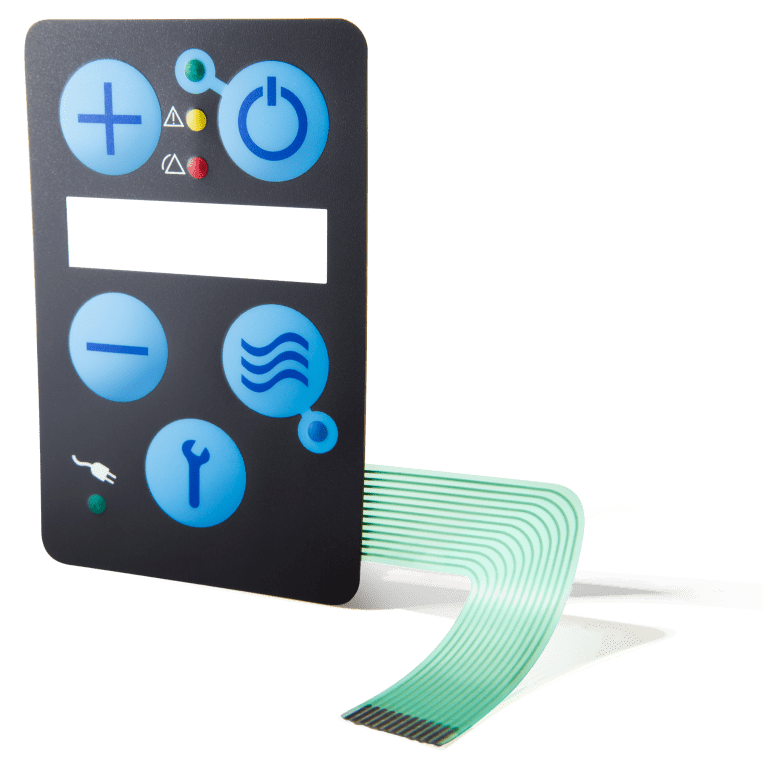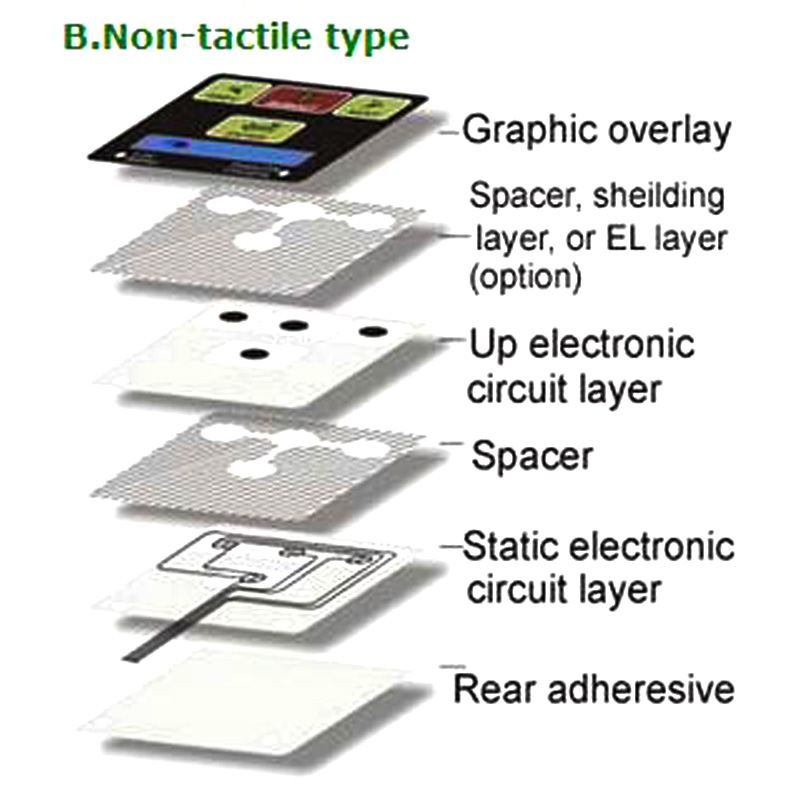Everything About Membrane layer Change: A Comprehensive Overview for Beginners
Membrane buttons are crucial elements in modern electronic devices, providing an unique user interface for user communication - membrane switch. Their layered building and construction, including overlays and conductive traces, gives performance and resilience. Unlike typical mechanical switches, membrane layer switches offer a sleek style and customizable choices. Understanding their crucial features and benefits can change item style. Nonetheless, the complexities of their application and layout considerations call for more exploration
What Is a Membrane layer Switch?
A membrane button is a sort of electrical switch that is composed of an adaptable membrane layered over a printed motherboard. This layout permits a smooth and small interface, typically made use of in various electronic devices. Membrane switches are frequently located in customer appliances, medical devices, and industrial equipment as a result of their sturdiness and resistance to ecological factors.The construction normally consists of multiple layers, such as graphic overlays and glue support, which offer tactile comments and shield the circuitry underneath. The operation of a membrane switch is started when pressure is put on the surface area, finishing an electrical circuit.These switches are valued for their versatility, making it possible for personalized designs and published graphics that provide to details user interfaces. Their inconspicuous nature lowers room requirements, making them optimal for applications where traditional switches may not fit. In general, membrane switches supply a visual and practical remedy for modern-day digital gadgets.
Secret Components of Membrane Switches Over
Membrane layer changes comprise numerous crucial elements that add to their functionality and efficiency. The top layer, known as the overlay, provides the interface and is commonly printed with icons or graphics. Below the overlay lies a spacer layer, which divides the conductive aspects and prevents unintentional activation. The next vital part is the visuals layer, which boosts appearances and guarantees the sturdiness of the design.Conductive traces, usually made from products like silver or carbon, are printed on the circuit layer. When pressure is applied to the overlay, these traces enter get in touch with, completing the circuit. In addition, a backing layer offers architectural assistance and can be made from materials such as polyester or polycarbonate. With each other, these elements develop a reputable, user-friendly user interface suitable for different applications, from house home appliances to commercial equipment. Recognizing these elements is necessary for anybody interested in membrane layer switch modern technology.
How Membrane Layer Switches Work
Comprehending how membrane changes feature is vital for valuing their widespread use in numerous tools. A membrane switch runs via a series of layers, including a graphic overlay, spacer, and a circuit layer. When stress is related to the overlay, it compresses the spacer layer, enabling the circuit layer to make get in touch with and complete an electrical circuit. This activity sends out a signal to the tool, motivating an action, such as activating a light or activating a function.Membrane changes can be created with numerous attributes, including tactile comments, backlighting, and custom-made graphics, boosting customer communication. Their construction allows for a sealed design, safeguarding the interior elements from dust, wetness, and pollutants. This longevity makes them ideal for varied applications, from customer electronic devices to commercial tools. On the whole, the simpleness and performance of membrane layer switches over add to their appeal in contemporary technology.
Advantages of Membrane Switches Over Mechanical Buttons
While mechanical buttons have actually long been a staple in lots of gadgets, membrane switches deal unique benefits that make them progressively appealing. One considerable benefit is their slim profile, enabling even more portable styles and greater flexibility in item advancement. Furthermore, membrane switches over function an uniform surface, which boosts aesthetic appeal and streamlines cleaning, making them suitable for settings where health is critical.Another advantage is their resistance to dirt and wetness. Unlike mechanical switches, which can be endangered by ecological elements, membrane layer buttons supply a sealed user interface that secures against impurities - membrane switch. Additionally, membrane buttons commonly have a longer life expectancy due to fewer relocating parts, causing improved resilience and reliability.Cost-effectiveness is additionally a significant benefit, as membrane layer switches can be generated wholesale with reduced manufacturing prices. These aspects combine to position membrane layer switches as a functional choice to conventional mechanical alternatives in various applications
Typical Applications of Membrane Layer Switches
Membrane buttons are widely used in different sectors, particularly in customer electronic devices and industrial control panels. In consumer gadgets, they give a sleek, easy to use user interface, while in commercial setups, they enhance sturdiness and capability. Understanding these applications highlights the flexibility and functionality of membrane layer buttons in modern-day technology.
Consumer Electronics Devices
As customer electronics continue to develop, membrane switches have ended up being a prominent selection for a selection of tools due to their versatility and sleek design. These switches are typically discovered in mobile phones, tablets, and push-button controls, where area is minimal and visual appeals matter. Their low profile and adjustable styles enable makers to develop user-friendly user interfaces that enhance the overall individual experience. Furthermore, membrane switches are commonly made use of in home navigate here appliances such as microwaves and coffee manufacturers, offering intuitive control options while resisting wetness and dirt. The toughness and dependability of membrane changes make them appropriate for everyday customer items, ensuring long life and consistent efficiency. Overall, their integration in customer electronics mirrors a blend of capability and modern-day style.
Industrial Control Panels
The applications of membrane switches over prolong past customer electronics, locating considerable use in commercial control panels. These switches are favored for their toughness and resistance to harsh settings, making them suitable for making and procedure control settings. They give a trusted user interface for operators to regulate machinery, display processes, and readjust settings. Membrane buttons can be customized to match particular functional needs, including features like backlighting and responsive responses, improving customer experience. Their low-profile style allows for combination right into various devices, while their ability to stand up to spills, dust, and extreme temperature levels guarantees durability. On the whole, membrane switches add to safe and reliable procedure in industrial applications, demonstrating their convenience and effectiveness sought after atmospheres.
Factors To Consider for Designing Membrane Changes
When making membrane switches, selecting the ideal products is vital to guarantee sturdiness and performance. In addition, recognizing layer configuration techniques can significantly impact the button's efficiency and individual experience. These factors to consider play a vital duty in developing dependable and effective membrane button designs.
Material Selection Significance
Material selection plays a necessary function in the style and performance of membrane switches. The chosen products straight impact the switch's sturdiness, tactile reaction, click over here and overall visual. Trick factors to consider consist of the substrate, which should provide architectural honesty while permitting versatility, and the graphic overlay, which needs to be immune to use and environmental factors. Conductive products must ensure reputable electrical efficiency, while adhesives need to provide strong bonding without endangering the button's operation. Furthermore, compatibility with making procedures and end-user environments is vital; products should withstand differing temperatures, humidity degrees, and chemical exposure. Inevitably, suitable material choice not only boosts the membrane button's performance yet likewise adds to its durability and user contentment, making it a vital aspect of the style process.

Layer Setup Strategies

Regularly Asked Questions
Exactly How Long Do Membrane Changes Usually Last?
Membrane buttons generally have a lifespan of 1 to 5 million her explanation cycles, relying on usage and ecological conditions. Elements such as layout quality and operating frequency substantially influence their longevity and overall performance long life.

Can Membrane Switches Be Customized for Details Layouts?
Membrane switches can without a doubt be tailored to fit particular designs, permitting varied shapes, shades, and performances. This flexibility enables suppliers to tailor these switches to fulfill distinct aesthetic and functional requirements properly.
What Products Are Used in Membrane Layer Change Construction?
Membrane layer switches are commonly built making use of materials such as polyester, polycarbonate, and glue layers. These materials supply resilience, adaptability, and resistance to environmental elements, making certain the switches function efficiently in numerous applications and problems.
Are Membrane Switches Immune or waterproof to Wetness?
Membrane buttons can be created to be moisture-resistant, making use of specialized coatings and products. Nevertheless, their water-proof capacities rely on construction quality and certain applications, making it necessary to analyze needs for perfect performance in various environments.
Exactly How Are Membrane Switches Repaired if Harmed?
Fixing damaged membrane switches typically involves changing the influenced layer or circuit. Professionals might likewise apply conductive glue or make use of specialized repair service sets, guaranteeing functionality is restored without full substitute of the entire button setting up. Unlike conventional mechanical switches, membrane layer switches present a streamlined style and adjustable options. A membrane layer switch is a kind of electric switch that is composed of a versatile membrane layered over a published circuit board. The operation of a membrane layer switch is initiated when stress is applied to the surface area, completing an electrical circuit.These buttons are valued for their flexibility, enabling custom-made designs and published graphics that cater to details individual interfaces. While mechanical switches have actually long been a staple in many gadgets, membrane switches over offer distinctive advantages that make them significantly appealing. Membrane buttons usually have a longer lifespan due to fewer relocating parts, resulting in boosted sturdiness and reliability.Cost-effectiveness is also a significant advantage, as membrane buttons can be produced in bulk with reduced manufacturing expenses.